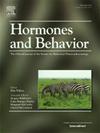Finger pointing: Why bias against 2D:4D ratios doesn't add up
IF 2.4
3区 医学
Q2 BEHAVIORAL SCIENCES
引用次数: 0
Abstract
In response to our invited review of the use of digit ratios such as 2D:4D as a retrospective marker of prenatal androgen exposure, the Editor-In-Chief of this journal published a Commentary disputing the findings we had reported, citing a preprint suggesting the sex difference in digit ratios was an artifact of “allometry”, and casting doubt on a previously published meta-analysis concluding that lesbians, on average, have lower digit ratios than straight women, suggesting there may be a bias against submitting negative results. Here we respond to those points and conclude that 2D:4D of the right hand remains the best available non-invasive retrospective indicator of prenatal androgen exposure in humans. Further, we offer a new dataset replicating once again the numerous previous reports that lesbians have significantly lower right-hand 2D:4D, indicative of greater prenatal androgen exposure, than heterosexual women, and further report that the ratios of bisexual women are intermediate between those of gay and straight women, without being significantly different from either. Together with previous reports, these new data further indicate that androgens act before birth in humans to promote the likelihood of being sexually attracted to women in adulthood.
指责:为什么对2D:4D比例的偏见不成立
作为对我们邀请的使用手指比例(如2D:4D)作为产前雄激素暴露的回顾性标记的评论的回应,该杂志的主编发表了一篇评论,对我们报道的发现提出质疑,引用了一篇预印本,该预印本表明手指比例的性别差异是“异位测量”的产物,并对先前发表的一项荟萃分析得出的结论表示怀疑,即女同性恋者的手指比例平均低于异性恋女性。表明可能存在对提交阴性结果的偏见。在这里,我们对这些观点做出回应,并得出结论,右手的2D:4D仍然是人类产前雄激素暴露的最佳非侵入性回顾性指标。此外,我们提供了一个新的数据集,再次复制了之前的许多报告,即女同性恋者的右手2D:4D明显低于异性恋女性,这表明她们在产前暴露于更多的雄性激素,并进一步报告称,双性恋女性的比例介于男同性恋和异性恋女性之间,没有明显的差异。结合之前的报告,这些新数据进一步表明,雄激素在人类出生前就起作用,提高了成年后被女性性吸引的可能性。
本文章由计算机程序翻译,如有差异,请以英文原文为准。
求助全文
约1分钟内获得全文
求助全文
来源期刊

Hormones and Behavior
医学-行为科学
CiteScore
6.70
自引率
8.60%
发文量
139
审稿时长
91 days
期刊介绍:
Hormones and Behavior publishes original research articles, reviews and special issues concerning hormone-brain-behavior relationships, broadly defined. The journal''s scope ranges from laboratory and field studies concerning neuroendocrine as well as endocrine mechanisms controlling the development or adult expression of behavior to studies concerning the environmental control and evolutionary significance of hormone-behavior relationships. The journal welcomes studies conducted on species ranging from invertebrates to mammals, including humans.
 求助内容:
求助内容: 应助结果提醒方式:
应助结果提醒方式:


